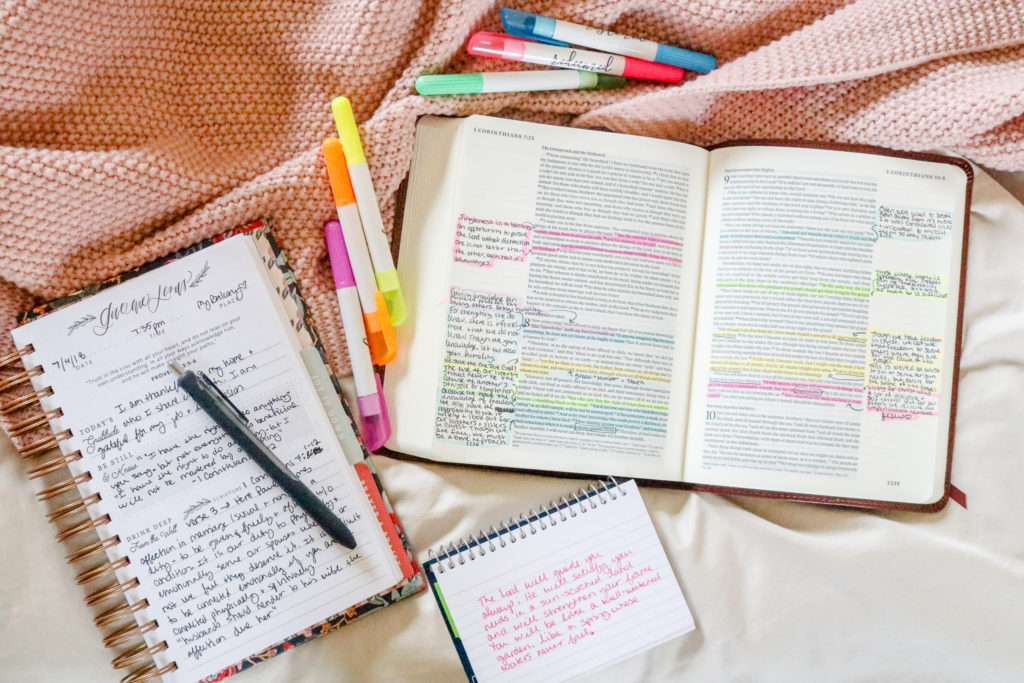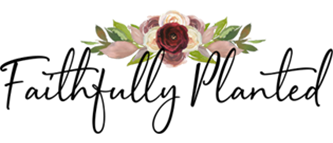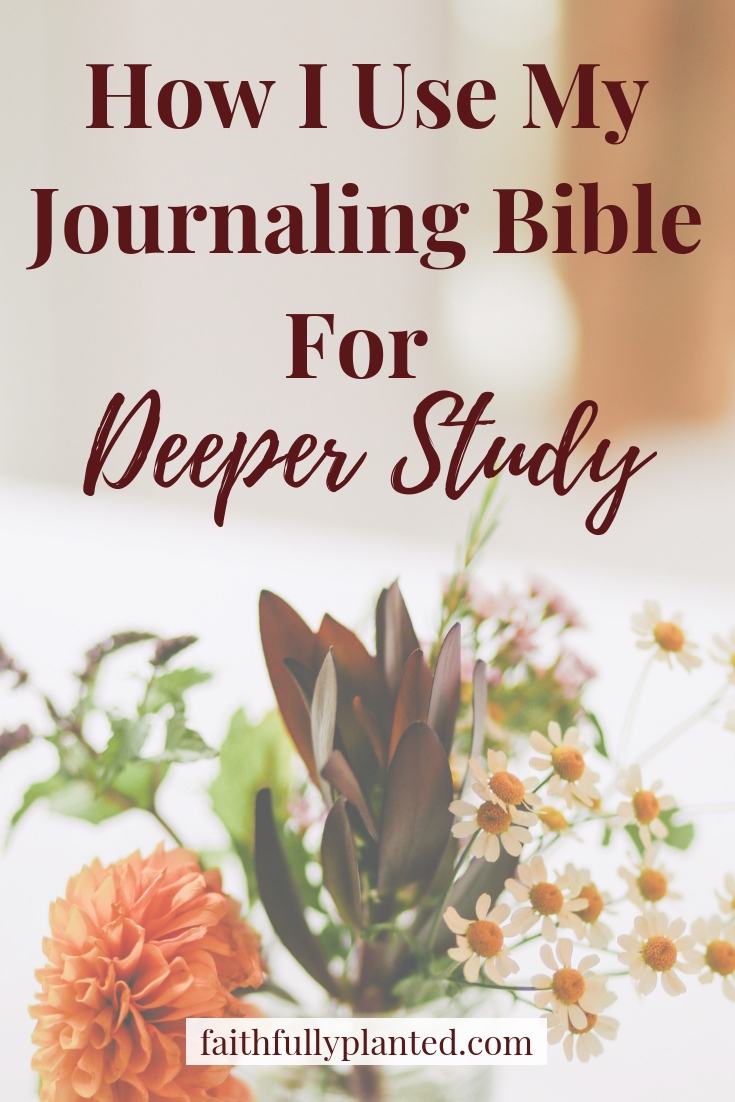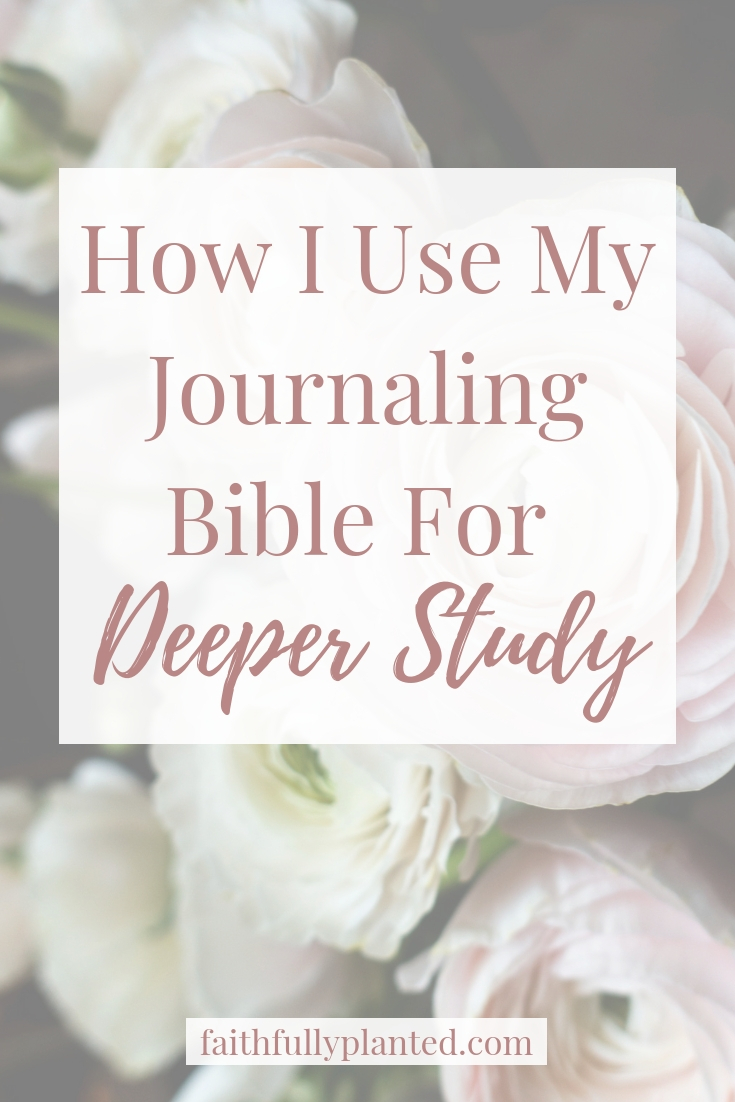
This post contains some affiliate links. If you make a purchase using my link, I may receive a small commission. I only recommend companies and products that I love and trust. This keeps the coffee brewing and the words flowing, so thank you for supporting Faithfully Planted!
What is Bible Journaling?
There are many methods within the umbrella of Bible journaling. It encompasses any type of writing within the pages of your Bible. This can include highlighting, underlining, writing notes, doodling, drawing, or painting.
Each of these methods seeks to connect more deeply with Scripture by physically working with the text.
I love to highlight and take notes in my journaling Bible during my study time. But the kind of journaling I am discussing in this post may be different than what you have come across on Instagram and Pinterest.
I’m an artistic person and I love doodling and painting and creating, but I don’t do those kinds of things on the pages of my Bible. If I want to creatively illustrate a verse or passage, I keep a sketchbook or acrylic painting book for that specific use.
I’m not discounting or condemning those who do artful Bible journaling. That just isn’t how I connect with Scripture in the pages of my journaling Bible. Every time I see a picture of a beautiful drawing in a Bible, I think to myself “but what if they wanted to make notes on that page!?”
Because that is how I connect with Scripture. I highlight and paraphrase and write notes all over the margins of my journaling Bible. Words are my creative outlet and I almost always run out of space in my journaling Bible to write.
I use both an ESV Single Column Journaling Bible AND an additional study journal and sometimes, even that isn’t’ enough space.
It wasn’t always like this for me, but once I started journaling, my ability to connect with scripture has grown and my study of the Bible has deepened.
That does not mean I’m right and people who draw in their Bibles are wrong. In this post, I am simply going to outline another way to use your journaling Bible to connect with scripture.
No art skills are required.

Gather Your Bible Journaling Tools
The first step in using your journaling Bible to study is to make sure you have the right tools!
ESV Single Column Journaling Bible: This one is the Bible I use. I actually bought the “customizable cover” version so I could paint my own cover. I like the hardback of this Bible, as it keeps my writing smooth and clean. The columns offer plenty of space to journal and write notes. ESV is my chosen translation but there are journaling Bibles for NIV, KJV, NLT, CSB, NKJV, and other popular translation choices. Choose the one that works best for you.
RELATED: How to Choose a Bible Translation
Bible Study Journal: Get a plain lined journal or a specific guided journal for bible study. There are lots of options out there, such as the Abide journal or the Give Me Jesus journal. I personally use the Give Me Jesus journal from Well-Watered Women.
Bible Journaling Pens: These are pens that write well on thin Bible pages. They write smoothly but do not bleed or smear. You’ll want thin pens so you can write small in the columns of your journaling Bible, such as these Micron pens that I use regularly.
Highlighters: that won’t bleed on your Bible pages. You can use regular school highlighters, but I use gel-based ones from the Daily Grace, Co because they are vibrant but very light so the words are still easily read.
RELATED: My Favorite Tools for Spiritual Growth
Prepare To Study

Choose a book of the Bible to study.
I recommend the Gospels, Romans, Acts or 1 & 2 Corinthians if you’re just starting out. If you want Old Testament, Genesis or 1 & 2 Kings are good starting books.
Insider Tip: you don’t actually have to read the books of the bible in order. You didn’t know that? Yeah, me either.
Gather additional study tools.
You can read through the Bible without any assistance, but at the
You can certainly do this research on your own. But there are a lot of options for tools that have done that work for you.
You can use a guided Bible study book, like the ones created by The Daily Grace, Co. or She Reads Truth or you can use free commentaries like those found at Blue Letter Bible. In addition to a commentary, I also use a study Bible in a different translation.
Set aside 30-60 minutes for study time.
Block out as much time as you have and start studying. Get as far as you can in that time frame. If you finish the chapter, great. If not, find a good place to segment the chapter and finish it tomorrow.
I used to let not having “enough” time or not reading a whole chapter hold me back from studying my Bible. But even if you only have 20 minutes a day and you get through a few verses, that is progress.
Little by little, your faith and understanding of the Bible will grow.
Pray.
Take a moment before you begin and ask the Holy Spirit to give you clarity as you read, to have a humble and teachable heart, and to have the opportunity to live out what you read. You may be tempted to skip this step. Don’t do that.
It is vitally important that you still your heart before the Lord and focus your mind on Him before you begin. Then, once you are done, pray about anything that was revealed to you during your study and thank God for the gift of His word.
RELATED: How To Start Studying Your Bible Better
Journal Through The Word
Now that you’ve prepared your tools and your heart, start marking up that Bible! There are a variety of things you can journal in the margins of your Bible.
Writing thoughts or things you are learning helps your brain to encode it in your long-term memory, so you actually learn what Scripture teaches.
Here are a few of the ways I use my journaling Bible to connect with Scripture:

- Paraphrase in your own words.
Do you remember in grade school when your teacher would make you rewrite a definition in your own words? He or she was not just giving you busy work. This exercise helps us to create neural pathways in our brains to remember what something means and helps us understand it. - Write out key verses.
If a verse resonates with you or you find yourself reading part of passage over and over again, write it out in the margins or in the space after a book (some journaling Bibles have a blank page between books!). You can even use pretty lettering. There is a lot of evidence in the education world that physically writing notes helps you learn. - Define words.
Maybe you come across a word you don’t know or you wonder about how it was translated. Research the definition or original meaning and write the information in the margins. When you study or read this passage again, the notes will be right there for your future self. - Write your questions.
Study materials help to answer a lot of the questions we have, but there can still be theological or practical questions that are more complicated. Put them right on the pages! This will get your brain stirring and will make it more likely that you’ll remember to ask another mature believer about their thoughts, such as a small group leader, pastor, or Bible teacher. You will also be reminded to do further research and read books on the topic. - Make note of cross-references or related verses.
Scripture often repeats itself and references itself. I especially love making note of when the New Testament makes reference to fulfilled prophecies or predictions. Doing this helps you to see how the Bible is one big story and it helps you connect what you are reading to other books and passages. - Write out applications to your life.
This is probably what I do the most of in the margins of my journaling Bible. Our lives should be reflections of what Scripture teaches, so I write out what lessons I learn from each passage and how I can live it out. Sometimes I’ll even write prayers in my Bible margins.
I pray your Bible study is blessed by using a tip or two that you’ve learned here. Ultimately, our purpose in knowing Scripture is to know God more and live in a way that glorifies Him.
Your Sister In Christ,




Great post!
Exactly what I was looking for. I tried the art journaling, but I did not connect memmories to it like I’d hoped. I see that I’m much more engaged with pen and paper. Just bought an ESV lined notes Bible. Loved your ideas. This really resonated. I’m an English teacher, so even though I doodle for fun, I’m not an artist at heart. Thanks for sharing!
I was looking for a picture to show someone what I was doing to help me stress levels. I found this image and then read the article. Thank you for the information. I am newer to Bible journaling and this gave me more ways to use my Bible.